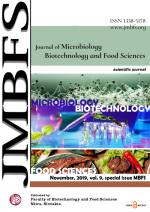SCREENING OF POLYPHENOLIC COMPOUNDS FROM TRADITIONAL MEDICINAL HERBS
DOI:
https://doi.org/10.15414/jmbfs.2019.9.special.487-491Keywords:
medicinal herbs, polyphenols, HPLC analysisAbstract
The aim of the study was to determine the antioxidant potential of dry herbal and aromatic plants by a qualitative and quantitative screening of polyphenols by HPLC analysis. The results of screening of polyphenolic compounds obtained by RP-HPLC-DAD analysis showed that flower of Anethum graveolens has 13-times greater total polyphenols content than its stalk. Flowers of dill were characterized by the highest content of gallic acid (224.0 μg/g), epicatechin (199.5 μg/g), trans-caffeic acid (38.6 μg/g), trans-p-coumaric acid (76.1 μg/g), kaempferol (10.9 μg/g), and apigenin (49.4 μg/g) in comparison to other analyzed plants from celery family. It was observed that in comparison to root (Apium graveolens var. rapaceum) and stalk (Apium graveolens var. dulce), leaves of Apium graveolens var. rapaceum have higher content of polyphenols (∑ 2,755.0 μg/g). Celery leaves are primarily rich in chlorogenic acid (1,790.2 μg/g), trans-ferulic acid (709.5 μg/g), and resveratrol (32.6 μg/g). Fruits of Tribulus terrestis were characterized by the highest polyphenols content among all the analyzed plant materials (∑ 4,780.0 μg/g), followed by extract of Calendula officinalis (∑ 3,515.0 μg/g). The results of this study confirmed that oregano is a good source of trans-caffeic acid, trans-ferulic acid, and apigenin. Both types of mint: Mentha piperita and Mentha longifolia were characterized by the smallest content of polyphenolic compounds among the herbs. In comparison to mint, over 70% greater content of studied biologically active compounds were present in lavender (Lavendula angustifolia) and sage (Salvia officinalis). In conclusion, the current study provided an experimental evidence that the extract from Anethum graveolens flowers and Apium graveolens var. rapaceum leaves, and also Calendula officinalis and Tribulus terrestris, might be promising candidates as health-promoting agents.Downloads
Download data is not yet available.
Downloads
Published
2019-11-08
How to Cite
Kulig, D., Matysiak, M., Baldovská, S., Å tefániková, J., Maruniaková, N., MňahonÄáková, E., Ãrvay, J., Galbavý, D., & Kolesárová, A. (2019). SCREENING OF POLYPHENOLIC COMPOUNDS FROM TRADITIONAL MEDICINAL HERBS. Journal of Microbiology, Biotechnology and Food Sciences, 9(Special issue), 487–491. https://doi.org/10.15414/jmbfs.2019.9.special.487-491
Issue
Section
Biotechnology
License
Copyright (c) 2022 Dominika Kulig, Michał Matysiak, Simona Baldovská, Jana Å tefániková, Nora Maruniaková, Erika MňahonÄáková, Július Ãrvay, DrahomÃÂr Galbavý, Adriana Kolesárová

This work is licensed under a Creative Commons Attribution 4.0 International License.
All papers published in the Journal of Microbiology, Biotechnology and Food Sciences are published under a CC-BY licence (CC-BY 4.0). Published materials can be shared (copy and redistribute the material in any medium or format) and adapted (remix, transform, and build upon the material for any purpose, even commercially) with specifying the author(s).





